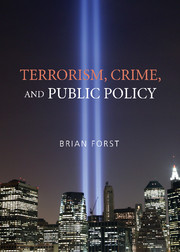Book contents
- Frontmatter
- Contents
- Credits
- Preface
- Acknowledgments
- 1 The Nature of Terrorism
- 2 Theories of Aggression and Terrorism
- 3 A Brief History of Terrorism
- 4 Two Trajectories of Humankind: Globalization or Clash?
- 5 Religion, the State, and Terrorism
- 6 Nonreligious Extremism and Terrorism
- 7 Technology and Terrorism
- 8 Terrorism throughout the World
- 9 Responses to Terrorism
- 10 Fear of Terrorism
- 11 Preventing Terrorism: Short-Term Approaches
- 12 Preventing Terrorism: Long-Term Strategies
- 13 Balancing Security and Rights to Liberty and Privacy
- 14 Toward a Safer and Saner Twenty-First Century
- Notes
- References
- Index
5 - Religion, the State, and Terrorism
Published online by Cambridge University Press: 05 June 2012
- Frontmatter
- Contents
- Credits
- Preface
- Acknowledgments
- 1 The Nature of Terrorism
- 2 Theories of Aggression and Terrorism
- 3 A Brief History of Terrorism
- 4 Two Trajectories of Humankind: Globalization or Clash?
- 5 Religion, the State, and Terrorism
- 6 Nonreligious Extremism and Terrorism
- 7 Technology and Terrorism
- 8 Terrorism throughout the World
- 9 Responses to Terrorism
- 10 Fear of Terrorism
- 11 Preventing Terrorism: Short-Term Approaches
- 12 Preventing Terrorism: Long-Term Strategies
- 13 Balancing Security and Rights to Liberty and Privacy
- 14 Toward a Safer and Saner Twenty-First Century
- Notes
- References
- Index
Summary
This chapter describes the major religions of the world in terms of their origins, holy scriptures, geographic centers, and distributions. It then discusses distinctions among religious moderates, fundamentalists, and extremists and describes connections between religion and the state and between religious extremism and terrorism, addressing these questions: Does religion cause violence, or does it serve more as a civilizing agent, by giving people a set of moral standards that deter terrorism? Has mainstream religion been hijacked by fundamentalists and extremists, criminals, and thugs? What role do governments and nongovernmental organizations play in mediating these relationships?
The Major Religions: Origins, Scriptures, Followers, and Links to Violence
Both of the trajectories of humankind discussed in the previous chapter – globalization and the clash of civilizations – were influenced by the Age of Enlightenment, which brought with it the flowering of the sciences and a gradual shift away from theological dogma and adherence to liturgies and symbolic rituals. The Enlightenment spawned a trend toward the secularization of politics, private affairs, and daily family life and what Mark Lilla (2007b) refers to as the “Great Separation” of the institutions of religion and state. Several intellectual giants of the nineteenth century – Emile Durkheim, Sigmund Freud, Karl Marx, Friedrich Nietzsche, and Max Weber, among others – saw clear evidence that knowledge from the sciences and ethical principles from secular philosophers were gradually replacing theological superstitions and symbolic rituals of ancient times, and would continue to do so as industrialization and the modern era took further shape (Norris and Inglehart, 2004).
- Type
- Chapter
- Information
- Terrorism, Crime, and Public Policy , pp. 101 - 136Publisher: Cambridge University PressPrint publication year: 2008

